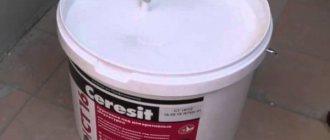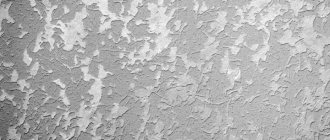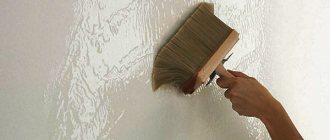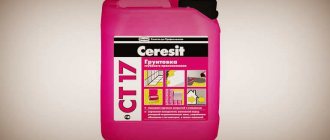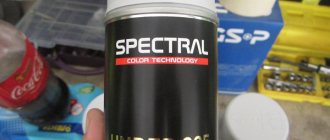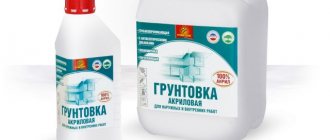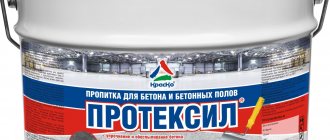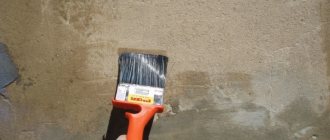Andrey
14086 1 13
Andrey June 5, 2017 Specialization: facade finishing, interior finishing, construction of dachas, garages. Experience of an amateur gardener and gardener. We also have experience in repairing cars and motorcycles. Hobbies: playing the guitar and many other things that I don’t have time for :)
What primer should I apply under decorative bark beetle plaster, and how should I do it correctly? I used to think about this question myself, but now, having some experience and knowledge behind me, I’m ready to answer it in detail. And the photo instructions will allow you to visually familiarize yourself with the application process.
Before applying the bark beetle, the walls must be treated with a primer.
Material properties
Ceresit CT 16 primer is a type of finishing material on a water-dispersion basis, which is intended to prepare the base for subsequent finishing. This brand of primer is universal - it is ideal for use under facade paints, decorative plasters, and is useful for interior and exterior work. Application of primer guarantees the longevity and reliability of the coating in the future.
The properties and features of the material are as follows:
- improvement of adhesion indicators - adhesion to other coatings;
- optimization of the finishing coating application process;
- providing protection from moisture - the surface acquires water-repellent qualities;
- deep penetration into previous layers during finishing work.
Adhesion due to coating with the material is improved due to the inclusion of mineral (quartz) sand in the composition, which gives the surface roughness. The primer does not cause a decrease in air permeability, is environmentally friendly, does not contain solvents and does not have an unpleasant, pungent odor. It is completely ready for use, which is very convenient for the user. The package contains 5 or 10 kg of soil, the cost of a smaller container is about 500 rubles.
What primer to use
The primer for decorative plaster is selected depending on the base. Additionally, the scope of application should be taken into account. Primers are designed for interior and exterior finishing. Compositions suitable for indoor use are characterized by a high degree of safety, i.e. they are environmentally friendly.
Adhesive
The degree of intermolecular interaction between the wall and the applied composition is an important criterion when choosing a primer. Therefore, if the wall is, for example, concrete, then preference should be given to adhesive primers. Their compositions contain dispersed filler (sand). Thanks to it, good adhesion between the base surface and the bark beetle is achieved. When using adhesive solutions, even a poorly prepared (dusty) base will be strengthened and will adhere well to the finishing solution.
Deep penetration
Primers with such characteristics are intended for good impregnation of the base. Such primers do not contain large dispersed particles, but the liquid itself has binding (gluing) properties. Construction mortars can saturate the base up to 10 cm.
After applying the primer, the pores on the wall close. Thanks to this, the base is strengthened and the consumption of building material is reduced. Additionally, the primer may contain substances that prevent the appearance and proliferation of fungus. Deep penetration formulations are well suited for old bases that are crumbling.
Universal
The universal product creates a uniform film on the surface, increasing adhesion and equalizing the absorption of the applied composition.
Despite the fact that the primer has several functions at once (strengthens, improves adhesion and creates a protective film), it is recommended to be used for processing:
- concrete;
- drywall;
- wood;
- plasters;
- old brick, etc.
Primer characteristics
The base color of the product is white, but it is possible to add tinting pigments according to the manufacturer’s card (color primers are made to order). You can also tint the Ceresit ST 16 primer yourself, which is sometimes required when carrying out plastering work with colored plaster.
A description of the technical characteristics of the material is given below:
- The structure is thick, homogeneous, without foreign inclusions.
- Temperature when applying the product is +5...+30 degrees, relative humidity - no more than 80%.
- Drying time for one layer is 3 hours.
- The density of the product is 1.5 kg/cu. dm.
- The speed at which the surface will absorb the primer is less than 0.5 kg/sq. m/hour*0.5.
Consumption of funds
Before treating surfaces inside or outside the house, you should check the consumption rates per 1 m2. This will help you purchase the right amount of primer. Consumption strongly depends on the surface's ability to absorb water and will range from 200 ml to 500 ml per square meter.
Manufacturers
When choosing an adhesive primer, you can choose the following products:
- Knauf-concrete contact;
- Perfecta;
- Tikkurila Otex;
- VGT.
The following deep penetration formulations have proven themselves to be effective:
- Perfecta;
- Litokol;
- Reference.
They respond positively to the Finnish-made universal plaster Dufa Putzgrund.
You can also use the following formulations:
- Ceresit CT-17;
- Knauf-Tiefengrund;
- Optimist.
Scope of application of the primer
Most often, the material is used to prime various bases made of concrete, mineral coatings, cement walls and floors, gypsum, and plasterboard products. It is also suitable for processing lime and other types of plaster, cellular concrete, and particle boards.
Since the primer does not allow the base color to show through a thin layer of plaster, it is often used in finishing work. Its use in bathrooms is indicated, as it protects the base from dampness. Similarly, protection against the effects of precipitation on the street is provided.
In addition to the indicated areas of use of this material, it can be used for:
- arrangement of facade insulation systems;
- priming the reinforced layer before laying decorative plaster;
- applied to the coating before painting it with acrylic, water-based, oil paints.
The primer significantly improves the adhesion and quality of application of silicone and wallpaper adhesives. Such a wide range of possible works makes Ceresit ST 16 in demand among ordinary users and professional builders.
Is it necessary to prime the base before the bark beetle?
Many beginners ask experts whether a primer is really necessary before the bark beetle? After all, priming takes time and increases financial costs.
To answer this question, below I will list what functions the soil performs:
- Improves adhesion . The primer provides good adhesion of the primer to the surface, and accordingly increases the durability of the finish. It must be said that this quality is of particular importance when applying plaster to smooth surfaces such as concrete;
The primer improves the adhesion of decorative plaster to smooth walls and ceilings
- Strengthens the surface . The soil penetrates the pores of the base and glues them together, thereby strengthening the surface. This quality is important for loose/porous surfaces;
- Provides uniform moisture absorption . The primer forms a film on the surface, due to which moisture is absorbed evenly and, accordingly, the decorative plaster dries evenly. It must be said that for the bark beetle, uniform drying is of great importance, since the quality of the grout largely depends on this;
The quality of the grout largely depends on the uniformity of the coating hardening.
- Has an antiseptic effect . Thanks to this, fungus does not form on the surface treated with primer. This quality is especially important when performing interior work.
From all of the above it follows that, in principle, you can do without soil. But it is impossible to guarantee the quality of finish and durability. Therefore, so as not to have to spend extra money on building materials and do the work twice, it is better to prime the base.
Surface preparation
Be sure to carefully prepare the base - this will guarantee the quality of the future coating. The base should be dry and not crumble. The surface is leveled and well cleaned of:
- fat and oils;
- dust and dirt;
- mastic residue;
- old paintwork.
Before applying primer, the surface should be checked for strength. To do this, it is felt and tapped; if necessary, fragile areas are cleaned and swept. Subsequently, the holes and cracks are plastered and leveled. Before priming, you also need to eliminate mold, moss, fungus and other defects of external and internal walls. When installing a screed that is located in damp rooms, the floor, as well as the walls, should be treated with special fungicidal mixtures.
To prepare, you should also do the following:
- Treat highly absorbent substrates (particle boards) with special primers for one layer (you can use Ceresit ST 17), then allow to dry for 4–6 hours.
- Cover the edges of doors and windows with paper tape to protect them from soil contamination.
- When applied to waterproofing, 3 days should pass after installation of the latter.
Tips for using Ceresit primers
To achieve the maximum effect from the Ceresit primer, it is necessary to take into account the specific application of the mixture.
Preparing the finishing surface
- First remove all remnants of paint, wallpaper, dust, etc. from the surface to be treated.
- Level the working area, depending on the parameters of the defects. Significant irregularities are covered with a layer of plaster, small irregularities are sealed using grout and a special trowel.
- If there is mold or any deposits on the finishing coating, they should be removed manually or with a special solution.
- Before use, the soil mixture must be thoroughly mixed. This is required for uniform distribution of active components throughout the entire container.
It is advisable to carry out all preparatory measures to remove minor defects 3 hours or a day before applying the Ceresit primer.
Features of application
Initially, it is necessary to check the tightness of the container and the expiration dates of the products. This helps prevent construction defects.
- It is recommended to distribute the primer in 1 layer over the entire area.
- It is best to carry out these works using a wide paint brush or a standard roller on a handle.
- If a second layer is required, it can be applied only after the first has completely dried, which occurs within 20 hours.
- It is not recommended to distribute the third layer.
The tools that were used to distribute the mixture should be washed immediately after surface treatment or placed in a container with warm water. This allows you to quickly remove any remaining solution.
The correct selection and use of Ceresit primer ensures high-quality preparation of the working surface for finishing with decorative and other materials.
Application of the product
According to the instructions, the soil does not need to be diluted; it is sold in finished form. It is enough to stir the material or shake it directly in the package. Prime with a brush; rollers are not used for this purpose. Apply the product in an even layer, not exceeding the consumption, avoiding drips and puddles. Usually one layer of soil is enough to improve the properties of the surface.
Drying time is 3 hours, but before decorative finishing it is better to wait 6 hours. The period will depend on the air temperature and humidity. Full compliance with technical specifications is achievable at a temperature of 20 degrees Celsius and a humidity of 60%.
After the soil layer has completely dried, it becomes resistant to mechanical damage, which is checked by rubbing with the edge of an iron grater. Tools are cleaned immediately - the product is easily washed off with water before it dries. Compliance with all recommendations will allow you to obtain high quality coating both on the outside of the house and inside the room.
Priming the bark beetle
So, we found out why and how to prime the walls before applying bark beetle. But, this decorative plaster, as you know, needs painting after application. Hence, beginners often have another question: do they need to prime the bark beetle before painting?
In order for the paint to apply evenly, the plaster must be primed
On the one hand, decorative plaster has a rough surface, so the adhesion of the paint and varnish material will be good even without primer. But on the other hand, as a result of the rather porous structure, the paint consumption is high, and the paint is absorbed unevenly, which appears on the surface in the form of spots. Therefore, painting has to be done in several layers.
Since the bark beetle has a textured surface, it is advisable to use a roller with medium or even long pile for priming and painting it.
To reduce paint consumption and ensure uniform color, the bark beetle is primed before painting. This process is carried out according to the scheme described above without any nuances.
A universal primer for bark beetles is usually used. You can also coat the surface with a deep penetration compound if, for example, it remains after treating the base.
If you run out of primer, you can dilute the paint with water in a ratio of one to two and use it as a primer.
This, in fact, is all the information about priming the surface before decorative bark beetle plaster, which I wanted to share with you.
